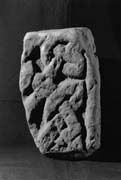Select a site alphabetically from the choices shown in the box below. Alternatively, browse sculptural examples using the Forward/Back buttons.
Chapters for this volume, along with copies of original in-text images, are available here.
Object type: Shaft fragment [1]
Measurements: H. 31.2 cm (12.3 in) W. 19.2 cm (7.6 in) D. 12 cm (4.7 in)
Stone type: Fine-grained deltaic sandstone with sub-angular grains and well sorted fabric. Reddish yellow (7.5YR 6/8). Certainly sandstone from the Saltwick Formation, Aalenian, Middle Jurassic. The nearest source for this material is the slope of the Hambleton Hills, north-east of Thirsk.
Plate numbers in printed volume: Ills. 690–1
Corpus volume reference: Vol 6 p. 185
(There may be more views or larger images available for this item. Click on the thumbnail image to view.)
A: On the left the broad edge moulding is damaged. Within the panel in the top left-hand corner is a large circular domed boss. Above it is a feature like a human foot. Down the left-hand side is a vertical serpent with one twist in its body and what must be a damaged head. To its right, the left-hand upper half of a human figure survives, with a round head, neck and shoulder.
B and C: Lost.
D: On the right is a broad modelled edge moulding. Within the panel are two registers of pattern E interlace linked by long diagonals in broad strand. These are in high relief.
This could be part of the same monument as no. 2, which also depicts a human figure with snakes in close proximity. The motif occurs too on the shaft from Masham, no. 3, now at Ripon (Ills. 696, 697), though that is carved by a different hand (pp. 49–50). The Stafford knots of face D are not gridded, but the pattern is an Anglian survival or a copy of an earlier monument. Face A is not as shown in Collingwood's drawing (1907, fig. g), which depicts the stone inverted.



